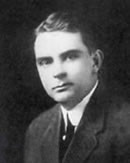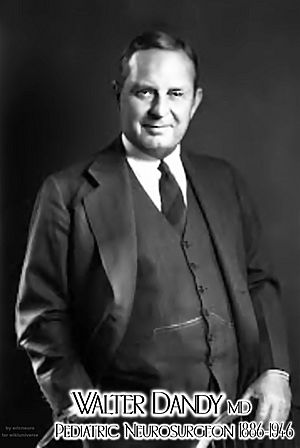Walter Dandy facts for kids
Quick facts for kids
Walter E. Dandy, M.D.
|
|
|---|---|
 |
|
| Born | April 6, 1886 |
| Died | April 19, 1946 (aged 60) |
| Citizenship | U.S. |
| Alma mater | University of Missouri; Johns Hopkins University School of Medicine |
| Known for | Research in neuroscience & neurosurgery |
| Awards | Nobel cited for two times (1937,1938) |
| Scientific career | |
| Fields | Physician & Neurosurgeon |
| Institutions | Johns Hopkins University |
Walter Edward Dandy (born April 6, 1886 – died April 19, 1946) was an American doctor and scientist. He became a very important neurosurgeon. A neurosurgeon is a doctor who performs operations on the brain and spinal cord.
Many people see Dandy as one of the main founders of neurosurgery. Other key figures include Victor Horsley and Harvey Cushing. Dandy made many new discoveries and methods in brain surgery. He was the first to describe how fluid moves in the brain. This fluid is called cerebrospinal fluid. He also found ways to treat a condition called hydrocephalus. This is when too much fluid builds up in the brain.
Dandy invented special X-ray techniques to see inside the brain. These were called air ventriculography and pneumoencephalography. He also helped create the first intensive care unit. He was the first to use a clip to treat a brain aneurysm. An aneurysm is a weak spot in a blood vessel that can burst. This was a huge step for brain blood vessel surgery.
During his 40 years as a doctor, Dandy wrote five books. He also published over 160 scientific articles. He performed about 1000 brain operations each year during his busiest times. People knew him as a very fast and skilled surgeon. Dandy worked at the Johns Hopkins University School of Medicine and Johns Hopkins Hospital his whole career. His work greatly helped the field of neurosurgery grow.
Contents
Early life and medical training
Walter Dandy was the only son of John Dandy and Rachel Kilpatrick. His parents came from England and Ireland. In 1903, Dandy finished high school in Sedalia, Missouri. He was the top student in his class. He then graduated from the University of Missouri in 1907.
In September 1907, Dandy started medical school at Johns Hopkins School of Medicine. He was able to skip the first year because he had already started medical studies in college. He graduated from Johns Hopkins in 1910 when he was 24.
Dandy then worked in a special lab with Harvey Cushing. Cushing was another famous neurosurgeon. Dandy earned a Master of Arts degree in 1911 for his lab work. He continued his training at Johns Hopkins Hospital. He finished his general surgery training in 1918. While Cushing first introduced Dandy to brain surgery, George J. Heuer finished Dandy's neurosurgical training.
In 1918, Dandy joined the staff at Johns Hopkins Hospital. He focused on treating brain and spinal cord problems. He became the only neurosurgeon at Johns Hopkins Hospital in 1922. He worked there until he passed away in 1946.
Amazing medical discoveries
Helping children with brain conditions
Dandy's first scientific work was a detailed description of a tiny human embryo. He published this in 1910, even before he finished medical school. He also studied the blood and nerve supply of the pituitary gland.
In 1913 and 1914, Dandy and Kenneth D. Blackfan made big discoveries about cerebrospinal fluid (CSF). They explained how CSF is made, moves, and is absorbed in the brain. They also studied hydrocephalus. This is a serious condition where too much CSF builds up in the brain. If not treated, it can be deadly.
Dandy and Blackfan found two types of hydrocephalus: "obstructive" and "communicating." This helped doctors understand how to treat the condition. Many people think this was one of the best surgical studies ever done. Modern doctors who specialize in children's brain surgery spend a lot of time treating hydrocephalus.
The Dandy–Walker malformation is a brain problem linked to hydrocephalus. In 1921, Dandy described a case where CSF flow was blocked. Later, in 1944, A. Earl Walker described a similar problem. This condition became known as the Dandy-Walker cyst. It involves problems with parts of the brain and too much CSF.
Seeing inside the brain with X-rays
In 1918 and 1919, Dandy published his important work on air ventriculography and pneumoencephalography. These methods allowed doctors to see brain problems on X-rays for the first time. This was a huge step forward!
To do this, Dandy would replace the fluid in the brain with air. The air would then show up on the X-ray, outlining the brain's structures. This helped surgeons find tumors and other problems. One doctor called it "the greatest single contribution ever made to brain surgery."
Air ventriculography needed a small hole drilled in the skull. In 1919, Dandy found a less invasive way. He called it pneumoencephalography. Air was injected into the lower spinal canal. Then, by moving the patient, the air would travel up to the brain. These X-ray techniques were the main way to find brain problems until CT scans came along in the 1970s.
New ways to perform brain surgery
By 1919, Dandy was already seen as a top surgeon at Johns Hopkins. He quickly developed many new surgical methods for the brain and spinal cord.
Here are some of his amazing surgical innovations:
- In 1921, he described how to remove tumors from a specific brain area.
- In 1922, he performed complete removal of certain brain tumors.
- Also in 1922, he used a special scope (endoscopy) to treat hydrocephalus.
- In 1925, he found a way to treat severe face pain by operating on a nerve.
- In 1928, he treated a type of dizziness by operating on nerves.
- In 1929, he removed a slipped disc in the spine.
- In 1930, he treated a condition causing neck spasms.
- In 1923, he removed an entire half of the brain (hemispherectomy) for severe tumors.
- In 1933, he removed deep tumors inside the brain's fluid-filled spaces.
- In 1935, he treated problems with blood vessels in the brain.
- In 1938, he used a clip to treat a brain aneurysm. This was a groundbreaking surgery.
- In 1941, he removed tumors from the eye socket.
Many of these operations are still done today, much like Dandy first described them! Some of his other contributions have been replaced by newer treatments. For example, in 1943, he published a surgery for high blood pressure. Today, high blood pressure is usually treated with medicines.
Pioneering brain blood vessel surgery
Dandy's 1938 surgery to clip a brain aneurysm was incredibly important. It started a whole new area of neurosurgery: treating blood vessel problems in the brain.
An aneurysm is like a small balloon on a brain artery. If it bursts, half of patients die right away. The others are also at high risk if it bursts again. Before Dandy, a ruptured brain aneurysm was almost always fatal.
On March 23, 1937, Dandy performed a difficult surgery. He placed a clip on an aneurysm in a patient's brain. This was done without the help of a surgical microscope, which makes it even more impressive. Even today, this type of surgery is one of the most complex and risky. This was the first time a brain blood vessel problem was successfully treated with planned surgery.
This success led Dandy to treat many other brain blood vessel issues. These included tangled blood vessels (AVMs) and other abnormal connections (AVFs, CCFs). In 1944, two years before he died, Dandy wrote a book about his experiences with these difficult brain aneurysms. Today, there is a special division at Johns Hopkins for cerebrovascular neurosurgery, named after Walter E. Dandy.
Dandy's "Brain Team"
Dandy created a special clinical service at Johns Hopkins Hospital. It helped his patients get excellent care. It also trained new surgeons to become neurosurgeons. This system was very organized and efficient. It allowed Dandy to perform over 1000 operations each year. It also trained 12 neurosurgeons who continued his work.
Dandy's service was known as the "Brain Team." By 1940, his team included a resident, an assistant resident, an intern, and several nurses and staff. The resident and assistant resident spent two years on the Brain Team. This was part of their eight-year general surgery training.
Personal life
In 1923, after finishing his demanding surgical training, Dandy started to focus more on his personal life. He had always been close to his parents. He even arranged for them to move to Baltimore in 1911.
Dandy met Sadie E. Martin in 1923. They married on October 1, 1924. They had four children: Walter Edward Jr., Mary Ellen, Kathleen Louise, and Margaret Martin. He said his family was "the finest thing in life."
He often went on vacations with his family when his children were out of school. However, he rarely traveled for work meetings. He preferred to stay in Baltimore, close to his family and his work. He once wrote that he didn't like joining societies because he felt they were "more social than beneficial" and he couldn't spare the time.
Dandy was healthy for most of his life. But on April 1, 1946, just five days before his 60th birthday, he had a heart attack. He was hospitalized and signed his will. He went home but had another heart attack on April 18. He was taken back to Johns Hopkins Hospital, where he passed away on April 19. He was buried in Druid Ridge Cemetery in Pikesville, Maryland.
Walter E. Dandy Neurosurgical Society
The Walter E. Dandy Neurosurgical Society (WEDNS) was started in St. Louis, Missouri in 2011. This group helps surgeons around the world learn more about neurosurgery. It also helps create guidelines for doctors to make good decisions using the best science.
See also
- Dandy–Walker syndrome
- Dandy's point
- Congress of Neurological Surgeons. This group has a special "Dandy Lecture" in honor of Walter Dandy at its yearly meeting.


